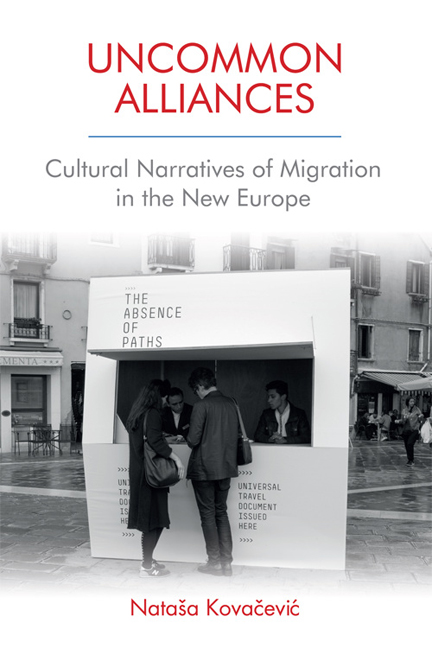Book contents
- Frontmatter
- Contents
- Acknowledgements
- Dedication
- Introduction
- 1 Performing the State: Artistic Re-Presentations of European Community
- 2 Alternative Hospitalities on the Margins of Europe
- 3 Colonial Spectres in Europe’s Historiography
- 4 Postcolonial and Postcommunist Contact Zones in a United Europe
- 5 Epilogue: Memories of Yugoslavia and Europe to Come
- Notes
- Bibliography
- Index
1 - Performing the State: Artistic Re-Presentations of European Community
Published online by Cambridge University Press: 01 May 2021
- Frontmatter
- Contents
- Acknowledgements
- Dedication
- Introduction
- 1 Performing the State: Artistic Re-Presentations of European Community
- 2 Alternative Hospitalities on the Margins of Europe
- 3 Colonial Spectres in Europe’s Historiography
- 4 Postcolonial and Postcommunist Contact Zones in a United Europe
- 5 Epilogue: Memories of Yugoslavia and Europe to Come
- Notes
- Bibliography
- Index
Summary
This is what is at stake in the new version of [EU] federalism: the relation between legitimacy and people. We cannot avoid questioning the lack of the former without asking who the European people is. Is it the European peace movement? This is insufficient and we are still faced with the dilemma, when we come across the Bismarckian position (with Nietzsche): the state is the people. This solution would create a statist idol and repress social conflict, what Gramsci called a passive revolution. That is not an active revolution, i.e. a party of the movement of the multitude, because in Europe we fear the masses, governments are terrorised by the idea that the masses might participate. (Étienne Balibar and Antonio Negri 2004: n.p.)
Like any other state, the EU has had to invent its people: it shores up support for its project by encouraging and disseminating a collective identity beyond what is exhausted by the national mythologies of each member state. Often this is done through a variety of cultural projects that cut across borders and represent the sheer diversity of peoples, styles and current topics, attracting large audiences outside of the restricted circuits of EU technocracy. Nonetheless, such attempts to foster a dynamic, new culture are frequently strained because of the unresolved relationship between the new EU state and the new EU people that Balibar discusses. For instance, it is unclear how we might imagine the EU as a multicultural and egalitarian state, as its official imagery suggests, when it is frequently criticised as a top-down, neo-liberal economic project, promoted by EU technocrats. These complaints about the EU's democratic deficit should be taken seriously: they suggest an ever-widening gap between the circles of EU decision-making and the populations on the ground, as seen after the popular referenda opposing the EU treaty and widespread protests in Greece, Spain and other countries in recent years, where the people refused to be represented by the state, effectively overturning the statist idol.
Perry Anderson argues that, constitutionally, the EU is a caricature of a democratic federation, since its Parliament ‘lacks powers of initiative, contains no parties with any existence at European level, and wants even a modicum of popular credibility’ (2009: 23).
- Type
- Chapter
- Information
- Uncommon AlliancesCultural Narratives of Migration in the New Europe, pp. 33 - 70Publisher: Edinburgh University PressPrint publication year: 2018



